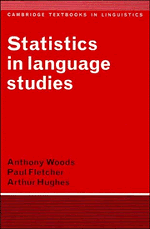Book contents
- Frontmatter
- Contents
- Preface
- 1 Why do linguists need statistics?
- 2 Tables and graphs
- 3 Summary measures
- 4 Statistical inference
- 5 Probability
- 6 Modelling statistical populations
- 7 Estimating from samples
- 8 Testing hypotheses about population values
- 9 Testing the fit of models to data
- 10 Measuring the degree of interdependence between two variables
- 11 Testing for differences between two populations
- 12 Analysis of variance – ANOVA
- 13 Linear regression
- 14 Searching for groups and clusters
- 15 Principal components analysis and factor analysis
- Appendix A Statistical tables
- Appendix B Statistical computation
- Appendix C Answers to some of the exercises
- References
- Index
3 - Summary measures
Published online by Cambridge University Press: 05 June 2012
- Frontmatter
- Contents
- Preface
- 1 Why do linguists need statistics?
- 2 Tables and graphs
- 3 Summary measures
- 4 Statistical inference
- 5 Probability
- 6 Modelling statistical populations
- 7 Estimating from samples
- 8 Testing hypotheses about population values
- 9 Testing the fit of models to data
- 10 Measuring the degree of interdependence between two variables
- 11 Testing for differences between two populations
- 12 Analysis of variance – ANOVA
- 13 Linear regression
- 14 Searching for groups and clusters
- 15 Principal components analysis and factor analysis
- Appendix A Statistical tables
- Appendix B Statistical computation
- Appendix C Answers to some of the exercises
- References
- Index
Summary
We have seen that diagrams can be helpful as a means for the presentation of a summary version of a collection of data. Often, however, we will find it convenient to be able to talk succinctly about a set of numbers, and the message carried by a graph may be difficult to put into words. Moreover, we may wish to compare various sets of data, to look for important similarities or differences. Graphs may or may not be helpful in this respect; it depends on the specific question we want to answer and on how clearly the answer displays itself in the data. For example, if we compare figure 3.1 (derived from data in table 3.1) with figure 2.4 we can see immediately that the lengths of the utterances of a mother speaking to an 18-month-old child tend to be rather shorter than those in the speech of the same woman speaking to a child aged 3 years.
However, it is quite rare for the situation to be so clear. In figure 3.2(a) we have drawn the histogram of the data of exercise 2.2 (reproduced in table 3.2), which consists of the total scores of 93 students at a Latin American centre in the June 1980 Cambridge Proficiency in English Examination. In figure 3.2(b) we have repeated the histogram of the scores of the European students already discussed in the previous chapter. The two histograms are rather alike but there are some dissimilarities.
- Type
- Chapter
- Information
- Statistics in Language Studies , pp. 25 - 47Publisher: Cambridge University PressPrint publication year: 1986



